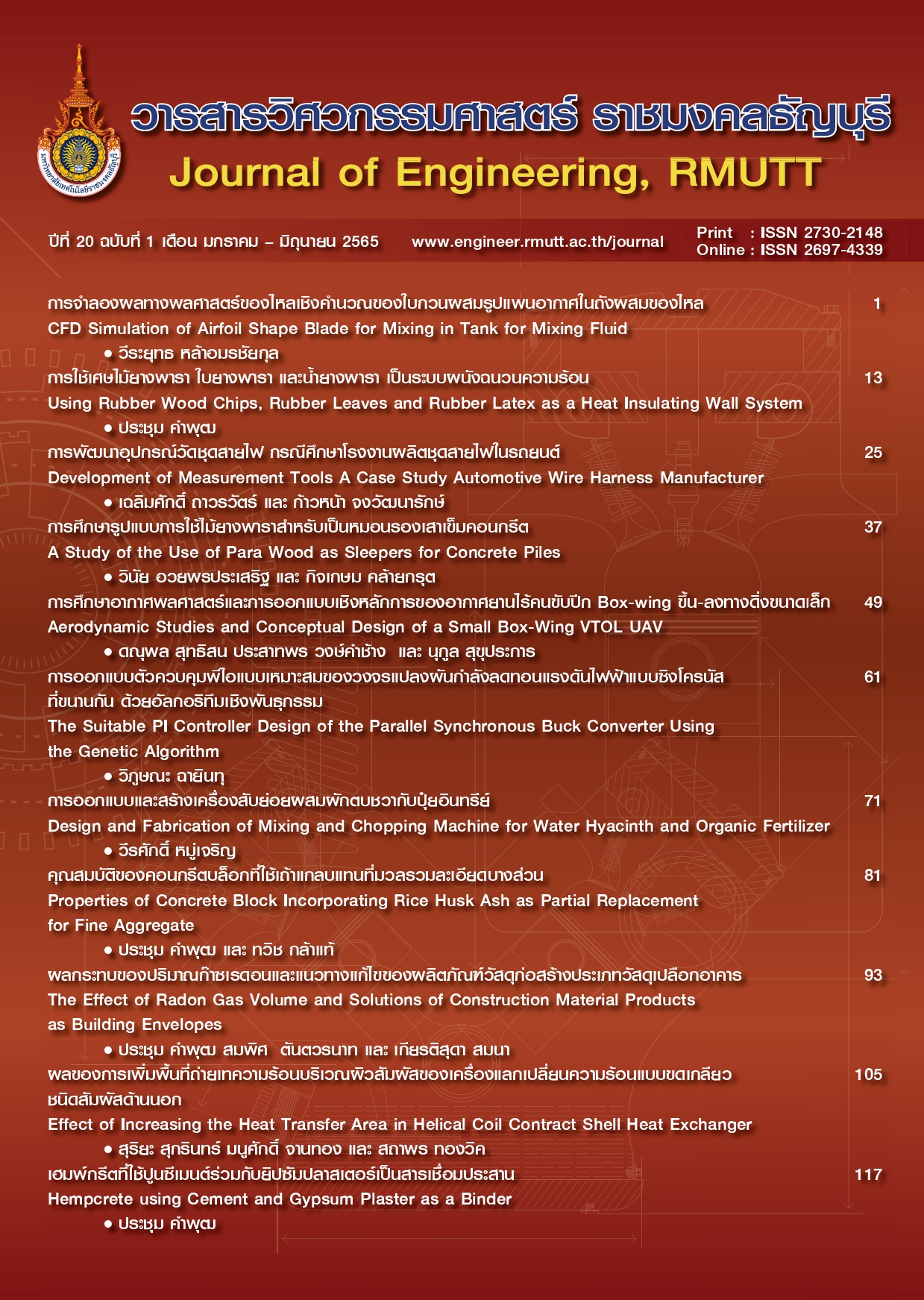Properties of Concrete Block Incorporating Rice Husk Ash as Partial Replacement for Fine Aggregate
Main Article Content
Abstract
This research aims to study the feasibility of using rice husk ash (RHA) partial fine aggregates replacement at ratio of ordinary Portland cement Type 1 (OPC) to RHA 1:3 (3RHA), 1:4 (4RHA) and 1:5 (5RHA) to produce concrete blocks. The properties of concretes such as compressive strength at 7, 14, 21 and 28 days, water absorption capacity drying shrinkage unit weight and thermal conductivity of concrete block at 28 days were investigated. The result showed that the compressive strength of concrete block decreased with an increasing rate of RHA replacement while water absorption of concrete block increased led to unit weight of concrete block was decreased. When the values were compared with the Thai Industrial Standards Institute TISI.58-2533 non-load bearing concrete blocks, which met the minimum specification of concrete block (than 2.5 MPa) at 28 days. The results indicated that the compressive strength of concrete block 3RHA and 4RHA were met the minimum specification. In terms of the production cost, RHA to partial fine aggregates replacement at ratio 1:3 (3RHA) and 1:4 (4RHA) reduction in the material cost by 8–19% compared with CT concrete block.
Article Details

This work is licensed under a Creative Commons Attribution-NonCommercial-NoDerivatives 4.0 International License.
The manuscript, information, content, picture and so forth which were published on Frontiers in engineering innovation research has been a copyright of this journal only. There is not allow anyone or any organize to duplicate all content or some document for unethical publication.
References
Krungsri Research. Thailand industry outlook 2022-24: Rice Industry. [Internet]. 2022 [cited 2022 APR 15]. Availability from: https://www.krungsri.com/getmedia/fd159784-6582-4f22-91e354549d3269ab/IO_Rice_220203_EN_EX.pdf.aspx
Jaturapitakkul C, Tangchirapat W. Utilization of waste ashes and waste materials from industries as concrete materials. 2nd ed. Bangkok: Thailand; 2012.
Chalee W, Sasakul T, Suwanmaneechoand P, Jaturapitakkul C. Utilization of rice husk-bark ash to improve the corrosion resistance of concrete under 5-year exposure in a marine environment. Cement and Concrete Composites. 2013;37:47-53.
Sata V, Tangpagasit J, Jaturapitakkul C, Chindaprasirt P. Effect of W/B ratios on pozzolanic reaction of biomass ashes in Portland cement matrix. Cement and Concrete Composites. 2012;34:94 -100.
Zain M.F.M., Islam M.N., Mahmud F, Jamil M. Production of rice husk ash for use in concrete as a supplementary cementitious material. Construction and Building Materials. 2011;25:798-805.
Intaboot N, Sreefung P, Nampunya S. Properties of concrete flow with rice husk ash mixing. 23rd National Convention on Civil Engineering; 2017; NakhonNayok, Thailand. p. MAT324. (in Thai)
Intaboot N. Guidelines and possibilities for the application of biomass materials for concrete block production. Journal of Thailand Concrete Association. 2017;5(2):1-10. (in Thai)
Chatveera B, Visantanon C. Potential to use concrete mixed with rice husk ash, not crushed. 7th National Convention on Civil Engineering; 2001; Bangkok, Thailand. 2001, p.63 -68. (in Thai)
Sukantapree S, Tangpagasit J, Jaturapitakkul C. A study of rice husk-bark ash as concrete block ingredients. Engineering Journal of Research and Development. 2003;14(3):1-7. (in Thai)
Sata V, Jaturapitakkul C, Kiattikomol K. Influence of pozzolan from various by product materials on mechanical properties of high-strength concrete. Construction and Building Materials. 2007;21:1589–98.
Dumrongsil S, Thepwong R. Compressive strength drying shrinkage and heat of mortar containing rice husk ash. 15th National Convention on Civil Engineering, Thailand, 2010, p.207 (in Thai)
Sua-iam G, Makul N. Utilization of high volumes of unprocessed lignite-coal fly ash and rice husk ash in self-consolidating concrete. Journal of Cleaner Production. 2014;78:184-94.
Onprom P, use of rice husk ash as partial sand replacement in lightweight concrete. Vocational Education Innovation and Research Journal. 2017;1(1): 1-15. (in Thai)
Hasnain M.H, Javed U, Ali A, Zafar M.S. Eco-friendly utilization of rice husk ash and bagasse ash blend as partial sand replacement in self-compacting concrete. Construction and Building Materials. 2021;273:121753.
Thai Industrial Standards Institute. Standard for hollow non-load-bearing concrete masonry unit (TIS.58-2533). Ministry of industry. 1990. (in Thai)
American Society for Testing and Materials. ASTM C150 Standard Specification for 364 Portland Cement. ASTM International. West Conshohocken, Philadelphia, United States. 2018.
Thai Industrial Standards Institute. Standard for sampling and testing concrete masonry units (TIS.109-2517). Ministry of industry. 1974. (in Thai)
American Society for Testing and Materials.ASTM C177 Standard Test Method for Steady-State Heat Flux Measurements and Thermal Transmission Properties.ASTM International. West Conshohocken, Philadelphia, United States. 2010.
Prak L, Sumranwanich T. Chloride binding capacity and water absorption of mortar containing fly ash, limestone powder, and expansive additive. Journal of Engineering, RMUTT. 2020;18(2):133-44. (in Thai)
Boontositrakul K, Suweero K, Weeranukul P. Using cassava pit waste as light weight aggregate for hollow load bearing concrete masonry mixed with rice husk ash product. Journal of Engineering, RMUTT. 2020;18(1):13-22. (in Thai)
Klathae T, Jitpat P. Compressive strength and water absorption properties of concrete block containing crushed oyster shell not process burning. RMUTP Research Journal. 2019; 11(2): 25-38. (in Thai)


